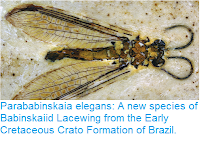Osmylids (Osmylidae) are a group of Neuropteran Insects with a fossil
record dating back to the Early Jurassic, with a stem group lineage (i.e. fossils of species more closely related to them than to anything else, but not descended from the last common ancestor of all living species), that are still in existence
today. They appear to have been at their most numerous and diverse in
the Middle-Late Jurassic, with a number of lineages apparently
disappearing at the Jurassic-Cretaceous boundary.Living Osmylids tend to be large, and often have strongly patterned wings. Their larvae have elongated, lance-like mandibles, giving the group the alternative name 'Lance Lacewings'.
In a paper published in the journal ZooKeys on 26 October 2017, Davide Badano of the Dipartimento di Scienze della Terra at the Università degli Studi di Genova, and Shaun Winterton of the California State Collection of Arthropods, describe two new species of Osmylids from Luzon Island in the Philippines. Both are placed in the genus Spilosmylus, which is found from East Africa across South and Southeast Asia and as far east as Australia.
The first new species is named Spilosmylus spilopteryx, where 'spilopteryx' means 'marked wing' in reference to the prominent, cloud-like markings in its wings. It is described from a single male specimen collected from the Tigaon area of Camarines Sur Province on southern Luzon. It is 10.48 mm in length, with a forewing length of 17.46 mm, and brown in colour with distinctively marked wings.
Spilosmylus spilopteryx, male specimen in dorsal view. Badano & Winterton (2017).
The second new species is named Spilosmylus tephrodestigma, where 'tephrodestigma' means 'coal spot' in reference to the grey spots found on its forewings. This species is described from a single specimen from the Barlig area of Mountain Province on northern Luzon Island. This specimen has a damaged abdomen, making it impossible to determine its sex or body length, but it has a forewing length of 21.43 mm, and is pale in colour with brown markings on its body and grey markings on its wings.
Spilosmylus tephrodestigma, specimen in dorsal view. Badano & Winterton (2017).
See also...
Follow Sciency Thoughts on Facebook.








